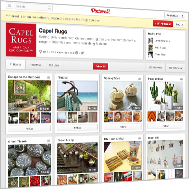
As the Internet becomes more and more visual, social media websites are focusing on sizable imagery to create a higher level of interest. We previously discussed marketing techniques with Instagram, but we haven’t yet focused on Pinterest. While both are image-heavy, the specific features of each site require two different approaches for planning marketing strategies and schedules.
Creating a Pinterest account for your company will certainly require time and attention, but the site’s user-friendly tools and grid-like layout make it easy to maintain. Between pinning your own products and searching the web for new images to pin, you’ll discover how addicting, fun, and beneficial Pinterest can be.
Capel Rugs, one of Rivers Agency’s clients, uses Pinterest to connect with followers on a level separate from their products and advertising outreach. Capel Rugs’ Pinterest has no singular focus — rather, it is a place where Capel collects inspiration and shares a variety of common interests, such as knitting, interior design, DIY projects, crafty design and, yes, some rugs. Here are a few ways that Rivers Agency helps Capel Rugs organize and prioritize their activity on Pinterest:
Organize: Separating your pins onto different boards not only makes managing Pinterest easier, but also caters to different people. Users can read the names of your boards and then choose to follow only those that appeal to their interests.
Pinning Products: Only pin your best products — don’t overdo it, though, or your boards will lose their non-advertising appeal. Spread your products across different boards so a variety of audiences will see them.
Follow: By following people whose Pinterest pages offer visuals similar to yours, you will have an easier time filling your own boards. When you follow someone, the images they pin will begin appearing on your homepage, making it easy to re-pin what they have posted.
Feature: Have one board where you feature your customers — for example, those who recently had a successful purchase or won a contest through one of your social media accounts. You’ll gain followers and make your customers feel special.
Pin, Pin, Pin: If it fascinates you, pin it. If you think it’s pretty, pin it. If you find it interesting, pin it. Chances are someone else will, too, and will re-pin it from you. It’s as simple as this: The more you pin, the more you’ll get re-pinned and the more exposure you’ll receive.
Quality: Only pin images of high quality. While browsing Pinterest, there is nothing more annoying than a tilted, pixelated image where you can barely make out the subject. Only the best images will go viral.
Naming Boards: You have the option to get creative and specific, so make it interesting. “Things I Like” and “DIY Projects” are generic and boring, but “Lighten Up” and “Let Me Finish This Row” (from Capel Rugs’ Pinterest) are more likely to spark an interest.
Using the “Pin It” Button: Incorporate the “Pin It” button onto images on your business’ website to enable quick and easy pinning for visitors. Not only does this tiny addition allow customers to pin your images, but it also makes your life easier when you want to pin one of your own products.
Maybe you feel that your products are not conducive to Pinterest, and you might be right. But, as mentioned with Capel Rugs, Pinterest marketing is not primarily about advertising products — it’s about finding similarities with followers and customers that you may not have otherwise found in your highly targeted marketing strategies. Recognizing those similarities and grounding that connection through a mutual following will forge a bond much deeper than just the basic producer-consumer relationship, leading to happier and more loyal customers.
